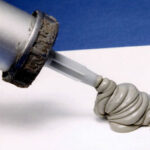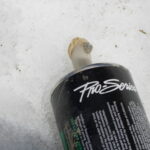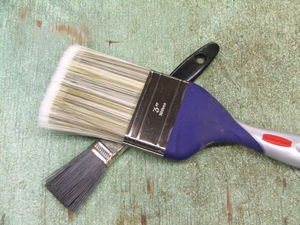I’ve often heard people complain about how difficult caulking is, and if you have heard this but still want to try it for yourself, then I’m going to list the steps on how to caulk a bathtub. The only difficult thing about it, is removing the old caulking, and if you have the right tools, even that can be a breeze. But what I’m going to focus on here, is caulking bathtub that already has the old caulk removed.
And once you have learned how to do this, caulking sinks, windows and baseboards will be a piece of cake. I have to say that even after hearing all the negative talk about caulking, I found it to be easy and simple, and after removing the old caulk and cleaning around the bathtub, it took me about 30 minutes to apply the caulk, smooth it out and clean off any excess.
If you take to heart what people say about it being hard to do, and very messy, then more than likely that is what you will experience. But trust me, it is easy and will only be as hard and messy as YOU make it.
Before you purchase your caulk, you need to decide on what type to get. You can buy the silicone caulks, which are very resistant to a lot of different contaminants and is suppose to last for at least 20 years. It will adhere to any surface in your bathroom, it’s very flexible and expands up to 100%, but these are more expensive, you can’t paint over them and they can be hard to clean up. You may need some type of mineral spirit to clean up.
They also sell urethane caulk, which is basically considered to be an all-purpose caulk. It will adhere to any material in your bathroom, it has good movement to about 300% and you can color match it by adding color packs, or you can leave it white. But this caulk doesn’t last as long and will begin deteriorating when it’s exposed to UV light. You also have to use mineral spirits to clean up.
You can also caulk bathtub with an acrylic/latex water-based caulk, which comes in different colors for matching with the color of your bathroom. They are less expensive, they clean up very well with water and you can paint over them. They will also adhere to any material in your bathroom, but what they aren’t is flexible. This is what I had to remove from around my bathtubs because it shrunk, got hard and then it started to crack, chip and fall off.
Since I wanted something that was really flexible that would last, I purchased the silicone caulk for caulking bathtub, tile and kitchens, and even though it is said to be hard to apply and clean up, I found that using this caulk and cleaning up wasn’t as hard as you would think.
Caulking Tools You Will Need:
• Caulking gun
• Silicone caulk
• Blue painter’s masking tape
• Caulk finishing tool
• Caulking Tips (optional)
• Wet cloth
• Rubber gloves
• Container of water
Cleaning The Area:
Make sure all the old caulk is removed and the area is well cleaned of dust, dirt and mildew. If your old caulk was silicone, it has to all be removed because silicone will not stick to silicone. So the area has to be thoroughly cleaned and dry before caulking.
You can use any cleaning product you have on hand, just be sure the surface is free of dirt, mildew and chemical residue.
Apply The Blue Painter’s Masking Tape:
Run the tape along both edges of the area that will be caulked. The distance of the tape from the caulking area will depend on the width of the area to be caulked, but 3/8 inches is what they generally suggest. The important thing is to have the tape running straight, so that when the caulk is applied and smoothed, the end results will look more professional.
Preparing Your Tube Of Caulk:
Before you slid your tube of caulk into the caulking gun, you want to cut the tip at an angle. Generally a 45 degree angle is suggested, but you will have to determine how high up or how low down on the tip to cut that 45 degree angle. The higher you cut it, the smaller the opening. The lower you cut it, the larger the opening.
Judge the size of the area to be caulked, then determine where on the tip to make your angled cut. It’s best to start small, then enlarge it if necessary, but if you cut the angle too large, there is no way to make that opening smaller. If you don’t want to deal with cutting, this is where you can use a caulking tip the size you need. Several sizes come in the pack, and you can purchase a pack for about $3 or $4 dollars.
Applying The Caulk:
If you don’t have your rubber gloves on, now is the time to put them on. Insert your tube of caulk into the caulk gun. Apply just pressure to the handle until you can see the beginning of the caulk. Starting at the corner of your bathtub, place the angled end of the tip flat against the area and press the handle of the caulking gun gently, but firmly and run a bead of caulk along the caulking area.
Don’t worry about any gaps you may have. When you smooth it out, the excess caulk will fill in those areas. Now that you have your bead of caulk along one wall, I would suggest you take the caulk finishing tool or caulking bathtub tool, dip it in a little water, then run it along the bead of caulk, smoothing out as you go, making sure all the gaps are filled between the tile and the bathtub, and that the edges along the masking tape are smooth.
Keep your caulking tool damp while smoothing and use your wet cloth to clean the tool of any excess caulk. Continue smoothing until that wall is done and you are satisfied with the results.
Now do the same to the other two walls, making sure your bead of caulk is smooth and filling the area between the tile and your bathtub completely, and don’t forget to keep your caulking tool damp while smoothing.
Completing The Job:
This basically completes the caulking process. All you need to do now is wait for about 2 hours before removing the blue masking tape. You don’t want to take it up too soon, and you don’t want to wait until the caulk is completely dry, so 2 hours is a good waiting period.
After 2 hours, check the tape by gently lifting one end and pulling it up smoothly and slowly. Hopefully it comes up without pulling up your caulk, if you get to an area where the edge of the caulking does pull up, gently put the caulk back in place, smooth it a little and continue lifting the tape.
The only thing to do now is wait until the caulk cures, which could be anywhere from 24 hours to 48 hours. The longer it has to cure, the better.
Some Important Tips On How To Caulk Bathtub:
You may want to try filling your bathtub with water before caulking, this extra weight causes the tub to settle and may prevent your cured caulking from drying with gaps and holes in it. I didn’t do this and my caulk cured perfectly without holes and gaps, but again, this decision is yours to make.
They say you have to use a solvent like turpentine to clean up when using a silicone caulk. I used a cheap caulking tool, cheap rubber gloves, and an old cleaning cloth. So there was nothing really to clean up. If you are careful when applying your caulk, there should be no mess to clean up, and anything else can be disposed of.
It takes about 8 hours for silicone caulk to dry, but it takes one to two days for it caulk to cure, I would suggest doing one bathtub at a time. You don’t want to tie up both bathtubs.
I used the G. E. Silicone caulk, but either this or DAP Silicone caulk is said to be the best. You don’t have to purchase either one, I just thought I would let you know which were considered to be the best brands.
Always check your expiration date on any silicone you’ve had for a while. If silicone is beyond its expiration date, it will not cure, it will remain soft and runny. You may want to purchase a new tube if you’ve had yours over a year. Especially if its been opened.
This completes How to Caulk a Bathtub. If these steps confused you or were not complete enough for you, then try looking for books on how to caulk bathtub and tile, or how to caulk bathroom and kitchen. You can purchase these books or get them from your nearest library. I hope you enjoyed this article.






